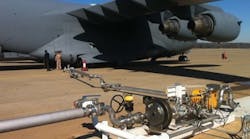Pendant recently was awarded the contract for a power-plant fuel-control system at the U.S. military airbase in Bagram, Afghanistan. Rob Ward, project engineer, credits robust control system components and its automation supplier's global support and engineering software for helping the company to succeed at Bagram — and for helping Pendant to replicate that success at other sites around the world.
The Cost of Entry
Extreme reliability in the face of harsh conditions, online system diagnostics, and global availability of spare parts and technical support were the cost of entry in Pendant's choice of automation platform, according to Ward. "Power down is not an option," he says.
The U.S. relies on diesel-powered generators to provide the electricity it needs to manage flights in and out of the airbase in Bagram, Afghanistan. Pendant Automation's diesel fuel control systems help ensure that the landing lights stay on.
Source: Pendant Automation
But the ability to keep costs down — through less expensive automation hardware and especially through fewer hours of development work — was equally important, as was the ability to test and validate code before shipping, since a traditional startup and commissioning process simply wasn't in the cards."We needed a PLC manufacturer who offered software that could identify potential problems within the programming — the kind of problems that might not show up in bench testing, but could show up later down the road," Ward says.
For the control system itself, the company settled on Siemens' new micro PLCs and HMI touchscreen displays communicating via Profinet. The system manages fuel flows among the 16 diesel storage tanks and 30 generator day tanks at Bagram. One control panel allows the tanker operator to offload diesel fuel into any of the 16 storage tanks. High and low tank level sensors inform the operator of tank status and prevent overfilling. A second control panel oversees automatic transfer of fuel from the storage tanks to any of the 30 generator day tanks without operator intervention. Maintenance technicians can verify fuel levels in any of the 46 tanks through one of the HMIs.
Easier Coding Cuts Costs
Though Siemens PLCs, HMIs and network components make the system itself robust, Ward says, Siemens' TIA Portal software is what made it possible for Pendant Automation to quickly and easily develop and troubleshoot the system — and reduce costs in the process.
TIA Portal software represents many man-years of development effort by Siemens to make engineering automation projects quicker and easier to do, according to Colm Gavin, product marketing manager, engineering software, Siemens Industry, who explains that the software essentially unifies automation logic, HMI development, hardware configuration and network architecture into a single integrated tool.
"It's a single framework designed to deliver maximum engineering efficiency," he says. "OEMs can reduce development and maintenance costs by spending less time engineering the control system and more time focusing more on essential core competencies."
The fuel control system relies on micro PLCs and touchscreen displays communicating via Profinet to manage fuel flows among the 16 diesel storage tanks and 30 generator day tanks at Bagram.
Source: Pendant Automation
Given the similarities among the 46 tanks involved in the Bagram system, it was an application rife with redundant programming tasks, according to Ward. "It used to take forever," he says. "But with the software's global library functionality, the time savings were huge. Once we established a function block that worked, we just replicated it 46 more times."Other time-saving features of the software that Pendant Automation says it found especially productive:
• Integration of the PLC, HMI and network configuration tools inside one programming environment, which allowed developers to drag-and-drop from one "view" of the project to another.
• Compact and intuitive project trees, which made navigation through the project easier and more fluid.
• A library of "send and receive" blocks, which made it easy to set up device communications.
• An integral runtime simulator, which allowed engineers to simulate and adjust the program while still under development.
"Even small details like the tool's easily configured time-of-day feature, which includes automatic compensation for daylight savings time, helped shave the development effort needed for global deployments," Ward says.
Good Metrics
In the end, Pendant Automation delivered a system 25% faster than it had in the past, and the system started up on site with no reported issues. Indeed, the military has come back for two essentially identical systems that vary only in the number of tanks needed.
Using the TIA Portal's function block capabilities, Pendant's engineers spent 30 minutes simply adding or deleting tank function blocks from the logic. "In terms of an ROI, the nearly 50 hours of initial programming time is now profit," Ward says.
The company also has been able to compete effectively to supply other customers at other sites around the world, with recent wins in the Bahamas, Iraq and Texas. "With a cost savings on average of nearly 30% over our competition," Ward says, "this has allowed us to compete in a wider variety of markets."



